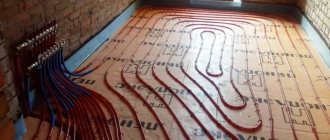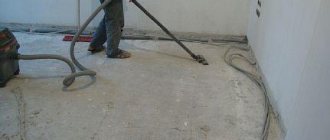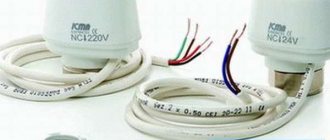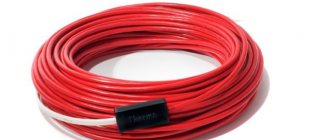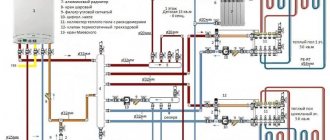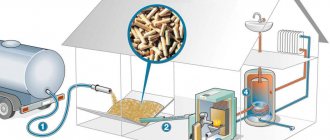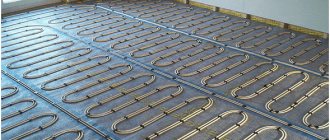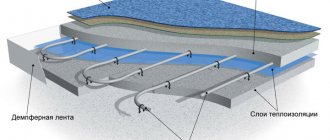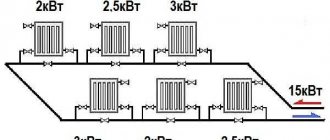In country houses, issues related to heating are not always easy to solve, since centralized city communications are out of reach and it is impossible to connect to them.
To effectively consume heat and increase the level of comfort when installing heating, you can install a heated floor system. Such artificial heating will allow for a more rational distribution and regulation of heat flows in the house. Gas boilers can heat water heated floors in a matter of minutes.
Connection
If the choice fell on heating using underfloor heating, then you will have to make the correct connection to the radiators.
A significant investment will be required, which will be aimed at piping the solid fuel boiler. In this case, you simply cannot do without a buffer capacity. The main reason is that it is quite difficult to heat a water floor to the required temperature using firewood, because we are talking about maintaining the temperature inside the system. Such a system requires timely heat release, otherwise the existing water jacket may overheat and even boil. It is very problematic to heat the coolant to 40°C using solid fuel, since its operating temperature is about 55°C. If the temperature drops, this will lead to the formation of condensation, which will eventually create holes in the metal walls. Even if you use a cast iron boiler, this will not help to avoid possible corrosion. In the presence of condensation, a characteristic deposit begins to form, which does not allow the fuel to burn efficiently. To maintain the efficiency of the entire system, it is necessary to install a heat accumulator.
Choosing the right boiler
The further microclimate in the rooms will depend on the gas boiler in the house. Often, such systems are chosen based on the cost benefits (outcomes) of one of the energy carriers. This approach, surprisingly, is the most correct one. When choosing a coolant, you should be guided by the following factors:
Boiler and heated floor
- The degree of complexity of the necessary installation work, which is aimed at installing complex equipment.
- Further degree of ease of use. The cost of its subsequent maintenance plays an important role.
- It is also worth considering the possibility of power outages and its complete shutdown in a particular region.
- Maximum and minimum system power.
- What is the most profitable energy source from an economic point of view?
The fact is that there is no company that produces heating boilers designed for heated floors. You can find models whose instructions contain information regarding its operation with heated water floor systems, but nothing more. The main distinguishing feature of floor circuits from radiator systems is the temperature of the main coolant. When using radiator systems, the coolant temperature can reach 80°C. The water floor pipes are only 55°C.
Boiler characteristics specification
In order to achieve an optimal indoor microclimate, the system must heat up to 40°C. The cooled coolant will have a temperature of 30°C. If radiators and heated floors are used for heating, which are supplied with heated coolant from the same boiler, then choosing a heat generator should not cause difficulties. Not every heat source can work to maintain the optimal temperature. To do this, you can additionally tie the unit.
Difficulties in connections may depend on the choice of one of the types of boiler and heated floor used:
- coal and automatic pellet;
- floor or wall gas;
- solid fuel;
- electric.
Boiler classification scheme
Types of boilers
All boilers are divided into two types:
- Double-circuit products.
- Single circuit products.
Double-circuit devices are capable of performing several tasks: water heating and heating. The water is heated due to the fact that such a boiler is equipped with a storage boiler. And some models, instead of a boiler, are equipped with a supply heat exchanger, which also provides water heating.
Single-circuit devices. In a heating system, such boilers only heat the coolant, that is, they can only be used to heat the house. But in order for them to provide water heating, then you need to additionally purchase: boilers, mixing units and many other devices. Only in this case will it be possible to connect a warm floor.
Based on the type of installation, boilers are divided into two categories:
- Suspended-type equipment, the power of which reaches up to thirty-five kilowatts.
- Floor-standing boilers have a power of up to one hundred and twenty kilowatts.
Among these two types, suspended models are the most popular because they require significantly less cost and are easy to install. Wall-mounted boilers are equipped with a circulation pump and other devices that are necessary for a boiler room. In order to put such equipment into operation, all that needs to be done is to attach pipes through which hot water will flow and connect the heating pipeline. Models that are equipped with a storage boiler are ready-made small boiler rooms from which water for the batteries will be heated.
If you are interested in which boiler is better to choose and how to connect a heated floor, you first need to find out what types of such equipment exist. To install a warm water floor system in your house, which will be heated by a boiler, you can consider the following types of automatic heating devices:
Electric water heating equipment.
- Single-circuit gas boiler.
- Double-circuit gas equipment.
To heat a water floor, you can choose any of these types, but there is an important condition here - the operation of such equipment must be automated. Most often, electric or gas 2-circuit equipment is chosen
However, if we take into account that the price of energy resources is constantly increasing, then installing a gas boiler is much more profitable from an economic point of view. However, in order to make a water heated floor connected to such equipment, you need to provide a separate room in advance, and also equip a good ventilation system.
In addition, a collector can be installed in a separate boiler room. A gas 2-circuit unit will be able to warm up the air well, plus it will provide the house with hot water. However, its installation for a warm water floor must be carried out in compliance with a number of important rules. Such work should be carried out by gas service workers, but independent installation of gas equipment will be considered illegitimate and will not meet accepted standards.
Installing an electric boiler, unlike a gas one, is not particularly difficult and can be done independently. Such heating equipment is environmentally friendly, which cannot be said about other types of boilers; moreover, the connection diagram for a heated floor to such a boiler does not require special knowledge. However, this unit has one big disadvantage - the high price of electricity, which is constantly growing. Electric heating devices can be installed both in private houses and in city apartments.
The diesel unit for the “warm floor” system is most suitable for installation in cottages. Installing such equipment is not very difficult; their installation scheme is quite simple. Diesel models are easy to use, however, in order to maintain their smooth functioning, they need to be constantly monitored.
Solid fuel heating units are also suitable for country houses. For their work, coal briquettes are used. As for the power of solid fuel boilers, it, like the efficiency (efficiency factor), is very high. In houses with heating radiators, a solid fuel unit is considered the best option.
It doesn’t matter which of these boilers you choose, before purchasing it you need to calculate its power, you also need to correctly find the place where the heated floor will be connected, and purchase additional devices, such as a storage boiler, etc.
Types of heat sources
Boilers for heating coolant can be of several types. They differ in the features of operation, installation and the type of fuel they operate on.
There are single-circuit and double-circuit heaters. The first ones are designed to serve only one heating line or heat water. The latter act as a heat source for the heating system and provide hot water supply (DHW). The unit cannot operate in both modes: when heating water for domestic hot water, the heating is turned off.
Depending on the installation site, boilers are divided into two types: wall-mounted and floor-mounted. The former allow you to save space, the latter are distinguished by great power.
Depending on the type of fuel, boilers are:
- Diesel. The fuel for them is diesel fuel. They are autonomous, have high performance with low fuel consumption, and are easy to install.
- Solid fuel. Anything that burns is used as fuel: coal, firewood, pallets, briquettes, etc. The process is reminiscent of burning wood in a conventional stove, only it takes place at elevated temperatures without air access. The medium is heated by hot smoke generated during combustion. They are used for autonomous heating in the house. They require constant loading of the firebox.
- Gas. The most economical and effective. At a low energy cost they have the highest efficiency. To connect to the water floor system, you will have to additionally turn on the distribution manifold and circulation pump.
- Electrical. They can work using electrodes, induction or heating elements. They are easy to operate, but they are the most expensive heat source.
When choosing a boiler for connecting a heated floor system, they are guided by the following criteria:
- compatibility;
- ease of installation;
- equipment power;
- the ability to regulate the heating temperature;
- efficiency;
- ease of use;
- safety;
- manufacturer.
The quality of heating and operating costs depend on the correct selection and connection of devices and equipment.
How to choose a solid fuel boiler for heated floors
When heading to the store to buy a solid fuel boiler, most people have no idea what exactly to look for. They rely on salespeople who often act in their own interests
Let's consider the issue of choice more carefully. The main criteria for a solid fuel boiler are the following parameters:
- Power.
- Power regulator.
- Energy dependence.
- Method of heating water.
Let's look at each of them in more detail.
When calculating the power, they take into account how well the room is insulated, as well as its area. On each boiler, the manufacturer indicates the volume that can be heated by the boiler in the absence of heat loss
Otherwise, buy a solid fuel boiler with a power 24% more than needed.
Manufacturers produce boilers with and without power regulator. It can operate automatically or manually. The first option is more economical.
The use of energy dependence in the design of a solid fuel boiler increases its performance, but makes the boiler dependent on the electrical supply and reduces the level of autonomy.
The method of heating the water plays an important role..
When a device is required not only for heating the house, but also for supplying hot water, then a double-circuit boiler is chosen, since it heats the water in flow mode. If a storage device is needed, a buffer capacity is installed.
How to choose sufficient boiler power
Calculate the required thermal power of the heating system source in order to correctly select boiler equipment.
If a gas fuel boiler is installed in the house, then the boiler room design will need to be completed and agreed upon with government agencies, for the subsequent commissioning of the equipment and obtaining permission from the gas inspectorate. One of the sections of such a project is the calculation of the thermal power of the heating supply circuit, which can be used to correctly select the equipment.
If you plan to install a solid fuel boiler or electric boiler in your house, then use a practical formula to calculate the load of the house. The formula has proven itself well for objects located in the central regions of Russia. For northern regions, an additional correction factor of 1.2 -1.3 is adopted. In addition, a correction factor is introduced for houses with a poor level of thermal insulation - 1.2 and if it is necessary to heat hot water - 1.2.
Power calculation:
Mk = 0.1*Po*k1*k2*k3
Where:
- Mk - boiler power, kW;
- Po is the area of the heating object, m2;
- k1—correction for thermal insulation;
- k2 - correction for hot water supply;
- k3 - amendment for area of residence.
Thus, for a heating area of 250 m2 with a domestic hot water load, in northern areas of residence and in a house with poor thermal insulation, the boiler power for a heated floor will be required:
Mk =0.1*250*1.2*1.2*1.3= 46.8 kW
For the same area in the central region of Russia you will need:
Mk =0.1*250*1.2*1.2= 36.8 kW
And in well-insulated private houses and without DHW load, the boiler is selected with the following power:
Mk =0.1*250= 25 kW
At the same time, the owner should not get carried away with increasing the power reserve; this principle is very harmful to the TP system, since it will cause overheating of the coolant with the subsequent creation of an emergency situation, and will also lead to an increase in the cost of thermal energy due to fuel burnout.
Safety requirements
Safety requirements for operating gas equipment are almost the same for all types of boilers.
Basic provisions
:
- a separate room is required to accommodate the gas boiler;
- The boiler room must be equipped with a gas analyzer so that in case of gas accumulation (for example, spontaneous extinguishing of the burner) it can be notified in time;
- there should be no foreign objects in the boiler room, especially flammable ones - paint, solvent, chemicals, etc.;
- the boiler must be free for air flow, it is prohibited to lean or lean anything against it;
- If you detect a smell of gas, immediately turn off the supply, notify the gas service and ventilate the room. When using propane-butane, ventilation may be useless, since it is heavier than air and accumulates at the bottom;
- Do-it-yourself repair of boiler safety sensors is prohibited.
The requirements are simple, but they must be strictly observed to avoid dangerous consequences.
Service Features
For uninterrupted and safe operation of gas boilers, it is necessary to carry out inter-service inspections and ensure repair of units. Prevention in most cases allows you to prevent emergency situations and increase service life. The frequency of service inspections during the warranty period is indicated in the documentation provided by the manufacturer. After completion of warranty service, it is recommended to carry out inspection and repairs twice a year. The organization carrying out maintenance is obliged to:
- control the operation of automation;
- check the functioning of the burners and replace them if they are unsuitable;
- inspect internal heating elements;
- examine the condition of taps and fittings for leaks;
- check the serviceability of ventilation and smoke removal systems;
- study the general condition for tightness of components;
- control the combustion of gas burners.
It is not recommended to carry out maintenance and cleaning of a gas boiler on your own due to the high responsibility of the procedure. A qualified specialist has not only professional experience, but also the necessary equipment for high-quality diagnostics. Therefore, even with appropriate experience, technical difficulties may arise. Failure to comply with operating rules and maintenance schedules leads to serious consequences. As a result, an explosion or fire occurs, which entails large financial costs. A warm floor, if installed correctly, will not bring any trouble.
DIY installation and connection of the boiler
A long-burning solid fuel boiler is sometimes installed with your own hands; for this you should follow a certain procedure:
- Perform preparations. Drawings and diagrams are checked. They choose the future premises, pour a concrete platform on which the equipment is mounted.
- Establish communications.
- Perform tying. The most labor-intensive stage of work. All communications are being connected. If the model is double-circuit, the return flow for water heating is connected. Next, a connection is made for additional equipment, for example, a buffer tank. If necessary, a draft regulator is installed.
- Install a brick chimney or other combustion exhaust element.
- Check the smoke exhauster and chimney.
- Perform final preparatory work.
- The system is started.
That’s all, the long-burning solid fuel boiler “Palych” (or any other) has been installed with your own hands and is ready for use. The first launch is performed outdoors. Pressure tests are also carried out before it. Turn on the water supply, having previously opened all plugs and valves, raise the system pressure to 1.3 Atm. Check the boiler for leaks
Particular attention is paid to joints and welding connections
Installation feature
Stages:
- Drawing up a plan and carrying out basic calculations. At the same stage, it is necessary to determine the length of the contours and the location of all working units.
- Cleaning and leveling the surface being used.
- Pie installation. It includes waterproofing, thermal insulation and a reflective layer. When using profiled mats based on polystyrene foam, pipes are laid on them. If the resulting layer is small, then an additional metal mesh is installed. She also plays the role of a screed. The pipes are attached to it.
- Pipes are being laid.
- All connecting elements, manifold, expansion tank, pumps and boiler are being installed.
- The tightness of the system and the operation of each circuit are checked.
- Arrangement of screed if necessary. After this, the floor is laid. If profiling mats are used, the screed will not fit. Placed on a layer of plywood or mats. In this case, specially marked material should be used.
An example of an installed gas boiler for underfloor heating
Choice
First of all, you should choose a water heater for underfloor heating of suitable power.
Calculating the power of a boiler is a difficult task; the easiest way is to proceed from the average value - 1 kW of power per 10 sq. m. area. It is necessary to pay attention to the possibility of adjusting the boiler operating mode. It is best if there is the possibility of smooth adjustment. It is also necessary to decide on the required number of circuits, type of installation and other characteristics of the boiler that will best meet the requirements of the existing room
It is also necessary to decide on the required number of circuits, type of installation and other characteristics of the boiler, which will best meet the requirements of the existing premises.
Arrangement technology
The necessary conditions:
- Installation will raise the floor by at least 10 cm.
- There is no need to save money; installing a heated floor, as well as external insulation, will allow you to save on heating.
- Select a coating for your underfloor heating system in advance.
- Temperature control sensors are installed in every room to save money.
- After pouring the screed, they begin to lay the system after 3 weeks.
An example of arranging a heated floor, most often used:
- Providing thermal insulation depending on the selected heating scheme.
- Creation of waterproofing. Installing a thin film that will prevent moisture from entering.
- When installing pipes, first carefully calculate the required number of pipes, and also fasten them with special tires so that when pouring concrete for screed, you do not damage their system.
- Starting installation work from the periphery and moving towards the middle of the room, the idea is based on the theory of thermal modulation.
- Filling the screed.
- Floor installation.
- Finish coating.
Laying scheme
How to make a heat accumulator with your own hands
A do-it-yourself heat accumulator for a solid fuel boiler is an energy-efficient and simple design, representing a container in the middle of which there is a coolant that receives and stores energy. After the boiler has completed its operating cycle, the room is heated by absorbing the previously collected energy. Thanks to this, the heat accumulator significantly increases its efficiency and significantly saves resources.
Heating from a solid fuel boiler (installed by yourself) with a heat accumulator consists of many spiral tubes that are located around the entire perimeter of the container. This arrangement is explained by the fastest possible use of heat. Each of the spiral circuits located in the container is responsible for one action. For example, the first receives the generated thermal energy, the second heats the area of the room (building), the third heats water for domestic purposes.
Advantages of using a heat accumulator:
- Accumulation and concentration of thermal energy.
- Possibility of combining two or more heat sources.
- Increase in productivity.
- Availability of water heating.
- Temperature adjustment.
A solid fuel boiler with a water circuit, installed by yourself, allows you to save money when it is equipped with a heat accumulator.
To make your own heat accumulator for a boiler, you will need a large capacity. It is almost impossible to make it yourself. The ideal option is a stainless steel tank or any container with a lid. The thickness of the steel used is 4-9 mm. The preferred shape is a cylinder or sphere, in extreme cases a cube.
A suitable option is a barrel. For a cottage or country villa, the minimum barrel volume for a solid fuel boiler starts from 1 ton. On large containers, before using them, stiffening ribs are welded on, which will significantly strengthen them.
Having received the necessary container, think about its location, since in the future it will be much heavier. Next, diagrams and drawings will be needed.
Let's look at the step-by-step production of a heat accumulator for a solid fuel boiler. The procedure for its manufacture:
- A flange is welded to the size of the cover. In the future it will be used for bolted connections. To seal the lid, stiffeners are installed.
- The surface inside is treated with orthophosphoric acid (solution), primed 4 to 6 times and covered with two to three layers of high-temperature paint.
- Welding work is being carried out. Coils are welded inside the barrel.
- If possible, powder coating is done along with the coil. It allows you to obtain a high-quality coating, which increases anti-corrosion properties.
- The main tank and coil are checked for leaks.
- The outside of the barrel is being sanded and painted. The preferred paint is silver.
- Insulated with a layer of aluminum foil and a thick ball of min. cotton wool.
Safety requirements:
Considering that the heat accumulator for a solid fuel boiler is constantly heating up, fire safety rules must be observed
Anything that catches fire quickly and easily is moved to a safe distance. A closed type system will have a fairly high coolant pressure; accordingly, special attention should be paid to welds, joints, and connections. It is also necessary to install heat-resistant rubber gaskets on the lid that can withstand the operating temperature of the coolant. In the case of using heating elements for additional heating, it is necessary to comply with electrical safety rules: the tank must have an “earth”, that is, grounding, and the contacts must be insulated.
Their use is beneficial when:
- Needs for supplying hot water to large facilities (public baths, hospitals, kindergartens, schools).
- Use of fuel materials.
- The use of thermal compressors (makes their work more balanced).
As you can see, installing a solid fuel boiler with your own hands is a rather simple and primitive thing, but at the same time it has a number of features. The element is installed both in an apartment and in a private house. Installation costs are minimal, savings are maximum. The assortment is varied, everyone will find something that suits them. Also, it should be noted that you can make a solid fuel boiler with your own hands for the garage. If you are not confident in your own abilities, call a specialist, he will do all the necessary work efficiently and on time.
Adaptability to working with heated floors
Most boilers are designed for traditional heating systems, that is, they produce a coolant with a temperature of 60-95 o C. The peculiarity of water floor heating is that much lower temperatures are required: about 35-50 o C. Only under such conditions the floor should not be burned it will be, but it will be pleasantly warm.
There are two solutions: find an installation that can dispense warm rather than hot water, or mix cold water with the hot water, and only then dispense it into the pipes. The second solution requires additional equipment - a collector unit, in which mixing occurs. This is not the cheapest technology, as it requires measuring the temperature of the hot water and return water, mixing them until the temperature drops to the desired level. Of course, collector units are different, more or less expensive, but they still need to be purchased and installed.
Let's start with boilers for water floors, which can themselves produce coolant at the required temperature. Here in the first place are electric thermal units. You can set the temperature yourself from 25 o C and above. That is, no additional costs and comfortable work with heated floors. In addition, induction and electrode (ion) boilers have very small dimensions, which makes them easier to install. If you have only one circuit, you can connect it directly to the output. If there are several circuits, a heated floor comb will be needed, but the simplest one, without mixing and temperature controllers. In principle, you can make it yourself from pipes and fittings. Other equipment may require (or not, depending on the configuration) an expansion tank, a drain valve and a circulation pump.
There is another option that simply shows excellent efficiency when working with low-temperature networks - this is. They are most effective when the coolant temperature in the return pipeline is not higher than 35 o C. That is, this is an excellent option for a water floor.
The best choice is a condensing gas boiler for heated floors
Gas boilers using traditional heat extraction technology require the installation of a mixing unit with control elements. If you decide to use such equipment, try to choose a model that can work with two or more circuits simultaneously. Usually one of them is high-temperature for radiators, and the rest are for low-temperature systems such as underfloor heating. In this case, monitoring the temperature and mixing the coolant is done automatically and everything happens inside the installation. So if your water heated floor works simultaneously with radiator heating, such equipment is an excellent solution.
The situation is more complicated with boilers using pellets and liquid fuel: for them, a collector (mixing) unit is required. And with all the stuffing: thermometers, controllers and thermal heads.
Wiring high-temperature boilers for heated floors is not the easiest task
Useful tips
Connecting heated floors to a double-circuit or single-circuit gas boiler requires caution and compliance with safety precautions at every stage. Therefore, while working, it is worth considering several practical recommendations:
- The distance to the nearest wall (perpendicular) should be at least 50 cm, and the gap between the surface of the boiler and the mounting wall should be 3-5 cm.
- Before connecting the equipment to the chimney, be sure to check the draft in the pipe.
- To prevent the heat exchanger from clogging, you can additionally install a water softening system in the inlet pipe.
- The floor heating system must undergo preliminary pressure testing. After this, the unit can be mounted to it.
Degree of autonomy
Requirements for the comfort of heating equipment are not the whims of spoiled consumers: not everyone has the opportunity to constantly monitor the operation of the heating system and add fuel. That’s why we consider this parameter first.
The highest degree of autonomy in . There is electricity - they work without human intervention. Moreover, after a power failure, they start working independently; many of them have “memory” and save settings. But there are three types of electric colas:
- on heating elements;
- electrode;
- induction
An electric boiler for underfloor heating with heating elements is a traditional solution. They just have one “disease” - heaters burn, and quite often. But their cost is average, and the technologies have been tested and proven; even a person who is not very good at communicating with technology can replace a burnt-out heating element. In general, a good (but not the best) option.
The most “independent” are solid fuel installations. You need to add fuel to them often, regularly remove ash and slag, and regulate the intensity of combustion. Of course I have, . The best models can work on one bed of coal for several days (up to 7 days for some models from the company). But there are also difficulties here: they are demanding on fuel (you need dry firewood or coal of a certain standard), and the price can also be a deterrent.
A solid fuel boiler for water heated floors requires constant human presence. Pyrolysis units and long-term combustion units require “refueling” two to three times less often
You can use a regular solid fuel boiler for a water heated floor, but you will have to spend a lot of time near the stove. Although there are already solid fuel units with automated supply. They are equipped with pellet-type bunkers and a screw feed. Only the requirements for the size and quality of fuel in them are no less stringent than those that run on pellets. But you can leave your home for a few days and not be afraid that the system will expand.
Fifth place for liquid fuel - it's not cheap. Operating costs also include the need to heat the fuel tank, or install the tank in a heated room. In addition, installations using diesel fuel require a boiler room. Moreover, it is better to build a boiler room at a decent distance from the house: the noise during operation of the burner is decent, and the smell is strong, and it penetrates everywhere.
It is generally accepted that the most expensive heating is electricity. But when using automated modern devices you have to pay only a little more than when using coal or firewood. So don’t discount electric boilers for heated floors. It’s just that for more economical heating, it is advisable for you to take a heating unit with the ability to adjust the power. In some traditional electric boilers, heating elements are assembled in groups, and automation, turning the groups on/off, regulates the operating power and saves energy. For heated floors, it is advisable to take a three-stage, or, in extreme cases, a two-stage unit. Induction and electrode boilers themselves are economical (if controlled electronically) and have low inertia, that is, they do not waste energy.
Advantages and disadvantages of the system
Typically, a heated TP heating system is easy to install and very cost-effective. It does not interfere with the residents, as it is built into the floor.
Does not require significant maintenance and free space on the wall under the window for the radiator. Such heating does not require high heating temperatures, which makes the system ideal for condensing boilers.
The radiated heat from the heated floor is distributed evenly throughout the room, so the person feels comfortable in it.
With traditional heating, warm air rises to the ceiling, thereby heating only the upper part of the room, leaving the lower part cold. This is very uncomfortable for residents of the first floor, especially when the room has a tiled floor.
A warm floor heats the house evenly, removing cold spots that are typical for radiator heating. Heat is transferred directly to the human body, so even if the room temperature is below +18 C, he will still feel the heat, unlike radiators. The TP system allows the use of any heating source, even a self-made boiler for heated floors.
The system has its drawbacks, which you need to know before making a heated floor. The most significant is the inertia of heating. It takes no more than 30 minutes to warm up a wooden floor, while a concrete floor takes one to several hours to warm up, depending on the depth of the installed pipe systems.
It is impossible to install heated floors over the entire area; the location of floor units and utility networks must be taken into account. During maintenance and repairs, the owner will have to remove the existing covering to access the heating cables or pipes.
Advantages of heated floors
Warm floors, compared to other methods of heating a house, provide the most uniform distribution of heat generated over the area of the room they heat. Flows of warm air from the floor rise vertically, displacing cooler air from the ceiling. As a result, constant natural convection currents are formed in the room. Convection provides effective heating of the entire room - at a minimum temperature of the coolant, the room receives maximum heat.
The temperature of the coolant in water heated floors must be maintained at 35-40 0 C. For radiator heating, the system must have a coolant supply at a temperature of 55-65 degrees. Thus, heating the underfloor heating system requires less thermal energy, and, therefore, the cost of heat production is lower. It is by reducing the cost of heat production that savings are achieved without loss of heating quality. In addition, the entire heated floor cake accumulates the released heat and, when circulation stops, will release thermal energy into the room for some time.
Features of connecting a heated floor to a gas boiler
First of all, it is necessary to determine the room in which the floor heating device will be located. This could be an outbuilding with a fairly strong wall (most models are wall-mounted) and the obligatory presence of a window. If this is not the case, you need at least a window. At the same time, there should not be any operating devices near the mechanism (within a radius of 2 m), including a gas meter.
The room in which the floor heating device is located must be equipped with natural or artificial ventilation
In addition, it is important to understand exactly whether you should contact a specialist or not. Usually you can do all the work yourself. The device is secured with brackets at a distance of at least 80 cm from the floor (for safety reasons). Next, it is connected to the water supply and gas pipe. It is the last stage that is the most critical. In many cases, it is better to turn to professionals.
Types by fuel type
Heating boilers are a fairly large group of devices that have different principles of operation. According to the type of fuel (energy source), boilers are
:
- Gas
. The most efficient and economical boilers. The cost of 1 kW of energy is the lowest, and the efficiency is the highest. - . Water is heated using heating elements, electrodes or induction. The easiest to maintain and most expensive source of heating fluid.
- Solid fuel
. Boilers that use almost everything that burns as fuel - wood, coal, briquettes, pallets, etc. The availability of fuel makes such a boiler most suitable for autonomous heating of a house, but the combustion chamber has to be constantly filled. Modern models, however, are capable of long-term combustion without human intervention. - Diesel
. The source of thermal energy is burning diesel fuel. A diesel fuel boiler can operate independently for a long time - up to several months. This type of boiler may turn out to be more profitable than even a gas one, if it is not connected to the mains, but uses imported gas. - Combined
. Boilers that have the ability to switch to another type of fuel if necessary. The design of such a boiler can have two fireboxes, or one universal for different types of fuel; you just need to replace the burner. At the same time, there are universal boilers with the option of converting wood to electricity when a second firebox is not needed. The ability to have an alternative heating option is a valuable quality for a country house when fuel shortages are possible.
Electric or liquid fuel boiler?
To compare two types of boilers, all factors must be taken into account. Despite the cheapness of diesel fuel compared to electricity, an assessment of all costs will show the real picture.
Initial costs for the purchase of equipment and installation costs An electric boiler is a ready-to-use device. A liquid fuel unit will require additional costs for the purchase of a boiler, mounted burner, and fuel storage tank. The difference in consumables is 2.5 times in favor of the electric one.
Installation of an electric boiler will cost several times less, since all the necessary elements for the control and safety of the equipment are built into its body. A liquid fuel device requires the installation of additional devices: a chimney, a fuel tank, and a mounted burner.
Operating Costs Maintenance of an oil boiler requires costs (several hundred dollars per year) for regular maintenance and cleaning. An additional inconvenience is associated with the need for constant orders for fuel delivery. Electric boilers do not require the listed operations.
However, electrical devices also have disadvantages.
- To operate the boiler, several tens of kilowatts of energy are required (1 kW per 10 m2 of area. The ceiling height is up to 3 m, and the room is well insulated). It is not possible to allocate such a volume of electricity in all areas.
- The cost of electricity is high and power outages occur. To protect against frequent power outages, a backup solid fuel boiler is often used.
If water heating is done in a house or apartment within a large city, then electric boilers are the most preferred of all types. This is due to strict environmental requirements and coordination problems.
Having analyzed the situation, we can highlight a number of advantages of electric boilers:
- low cost;
- compactness and light weight;
- easy installation, no chimney required;
- safety (no open flame);
- ease of operation;
- can be installed in any room;
- service is simple;
- environmentally friendly: no emissions and odors;
- silent.
Results
So, what should you choose? The best option is a gas boiler for heated floors with condensing heat extraction technology. In all three respects, it occupies good positions. The situation is a little worse if you install a gas installation with a “warm floor” function. But, unfortunately, not everyone has the opportunity to connect to main gas. And then the easiest way to implement a water heated floor with an electric boiler. A small electric boiler can be installed to heat heated floors in utility rooms, for example, in a garage or in a country house: it is very easy to install. The next “quality” unit is a pellet unit, followed by liquid fuel. The most difficult task and high costs await when using solid fuel boilers for water floor heating.
Schemes of warm water floors from a gas boiler
There are several options for connecting a gas boiler to floor heating; the most common diagrams are presented below.
Basic connection diagram
Connecting a gas boiler
Diagram with two-way thermostatic valve
Circuit with pressure gauge and electric pump
